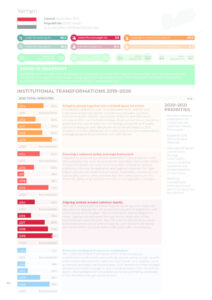Nutrition situation
Under five stunting (%)
46.4
Under five overweight (%)
2.5
Anaemia in women 15-49 years (%)
69.6
Under five wasting (%)
16.4
Low birth weight (%)
31.4
0 to 5-month-old exclusive breastfeeding (%)
9.7
Adolescent overweight (%)
Male: 17.4
/ Female: 19.3
Adult overweight (%)
Male: 44.1
/ Female: 53.3
Adult obesity (%)
Male: 12
/ Female: 22
Adult diabetes (%)
Male: 12.6
/ Female: 10.1
COVID-19 snapshot
Guidelines and manuals were developed, and diagnostic kits and PPE were purchased from own resources and with United Nations support. Aden issued a daily report and surveillance data, while Sana’a did not publicly share data. Lockdown was minimal in all governorates limited to certain activities.
Institutional transformations 2019-2020
Bringing people together into a shared space for action
Increased coordination was noted between both national and international partners: better coordination between nutritionrelated ministries (Health, Agriculture, Fisheries and Education), increased efforts on the humanitarian development nexus, and intergovernmental coordination on monitoring, standards and quality control. A dialogue with the private sector should lead to a SUN Business Network (SBN)and civil society organisations implemented strategic projects in partnership with SUN Yemen.Ensuring a coherent policy and legal framework
Regulations promoting nutrition sensitivity in various sectors were discussed, but the main focus is on the regulatory framework aimed at expanding basic services to communities. Changing national policies to improve the legislative and legal environment for highimpact sectors like water and sanitation, food safety, marketing, and food quality control were reviewed, but the current political crisis limits the ability of government to rule on any legislative changes.Aligning actions around common results
The CRF is revised and finalised. Regular meetings were held with key actors to discuss the CRF’s interventions and its alignment with national and sectoral plans. The humanitarian and development nexus is being strengthened through better alignment of the humanitarian response plan, the CRF and ministerial sector plans. Enhanced private sector and civil society contributions are being discussed. Efforts to implement a SBN action plan are ongoing.Financial tracking and resource mobilisation
The Common Results Framework (CRF) is also a resource mobilisation mechanism, used with the private sector as well as with international development partners. Most funds were used for social protection and basic service provision. SUN Yemen’s nutrition budget analysis expanded its scope to also include partners from the private sector. Partnerships with the private sector are promising, especially in the fisheries and agriculture sectors.2020-2021 Priorities
- Increase resource mobilisation to implement the Common Results Framework.
- Establish SUN Networks and Alliances.
- Advocate for better coordination among stakeholders and an enabling legislative and implementation environment.
- Building multisectoral institutional and technical capacities for nutrition.
Download

